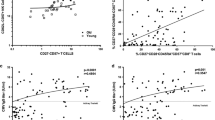Abstract
T cell subpopulations were obtained from F12.5 and B245/270D T cell lines during long-term culture. Two altered F12.5 subpopulations proliferated more intensively than the original clone. These two subpopulations of F12.5 constantly expressed CD25 (interleukin 2 receptor α chain) at a high level and exogenously added interleukin 2 (IL-2) enhanced cell death for one of these subpopulations. However, the original clone expressed CD25 only after activation and IL-2 inhibited cell death of the original clone. On the other hand, the altered B245/270D subpopulation lost the antigen-specific proliferation ability. This altered cell line under the stimulation culture did not express CD25 even after activation, although the original line expressed CD25. However, the expression pattern of CD25on the altered cell line at resting state was induced similar to that of the original one. These results suggest that an expression pattern of CD25 can be changed during long-term cultures, accompanied with alteration in response to proliferation and cell death.
Similar content being viewed by others
References
Achaffenburg R and Drewry J (1957) Genetics of the β-lactoglobulins of cow's milk. Nature 180: 376-378.
Brand DD, Myers LK, Terato K, Whittington KB, Stuart JM, Kang AH and Rosloniec EF (1994) Characterization of the T cell determinants in the induction of autoimmune arthritis by bovine α1 (II)-CB11 in H-2q mice. J Immunol 152: 3088-3097.
Ku CC, Kappler J and Marrack P (2001) The growth of the very large CD8+ T cell clones in older mice is controlled by cytokines. J Immunol 166: 2186-2193.
Lenardo MJ (1991) Interleukin-2 programs mouse αβ lymphocytes for apoptosis. Nature 353: 858-861.
Lipkowitz S, Greene WC, Rubin AL, Novogrodsky A and Stenzel KH (1984) Expression of receptors for interleukin 2: Role in the commitment of T lymphocytes to proliferate. J Immunol 132: 31-37.
Sadlack B, Merz H, Schorle H, Schimpl A, Feller AC and Horak I (1993) Ulcerative colitis-like disease in mice with a disrupted interleukin-2 gene. Cell 75: 253-261.
Sakaguchi S (2000) Regulatory T cells: Key controllers of immunologic self-tolerance. Cell 101: 455-458.
Scola MP, Thompson SD, Brunner HI, Tsoras MK, Witte D, van Dijk MA, Grom AA, Passo MH and Glass DN (2002) Interferon-γ: Interleukin 4 ratios and associated type 1 cytokine expression in juvenile rheumatoid arthritis synovial tissue. J Rheumatol 29: 369-378.
Seder RA and Paul WE (1994) Acquisition of lymhokine-producing phenotype by CD4+ T cells. Annu Rev Immunol 12: 635-673.
Suzuki H, Kündig TM, Furlonger C, Wakeham A, Timms E, Matsuyama T, Schmits R, Simard JJL, Ohashi PS, Griesser H, Taniguchi T, Paige CJ and Mak TW (1995) Deregulated T cell activation and autoimmunity in mice lacking interleukin-2 receptor β. Science 268: 1472-1476.
Taniguchi T and Minami Y (1993) The IL-2/IL-2 receptor system: A current overview. Cell 73: 5-8.
Thornton AM and Shevach EM (1998) CD4+CD25+ immunoregulatory T cells suppress polyclonal T cell activation in vitro by inhibiting interleukin 2 production. J Exp Med 188: 287-296.
Totsuka M, Furukawa S, Sato E, Ametani A and Kaminogawa S (1997) Antigen-specific inhibition of CD4+ T-cell responses to β-lactoglobulin by its single amino acid-substituted mutant form through T-cell receptor antagonism. Cytotechnology 25: 115-126.
Wilkinson PC and Liew FY (1995) Chemoattraction of human blood T lymphocytes by interleukin-15. J Exp Med 181: 1255-1259.
Author information
Authors and Affiliations
Rights and permissions
About this article
Cite this article
Kano, H., Ametani, A., Totsuka, M. et al. Murine T cell lines can change CD25 expression patterns as well as proliferation and cell death patterns in response to interleukin 2. Cytotechnology 40, 39–48 (2002). https://doi.org/10.1023/A:1023910004242
Issue Date:
DOI: https://doi.org/10.1023/A:1023910004242




